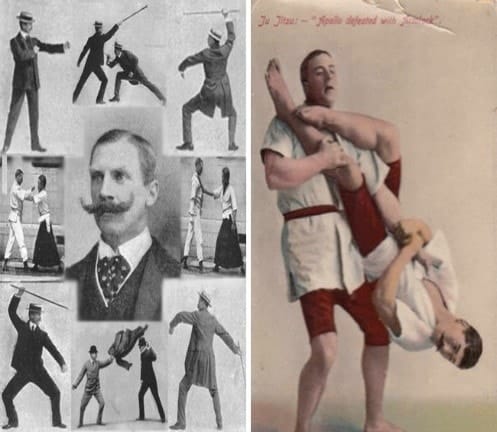MMA in the UK has quickly blossomed into one of the most popular sports practiced. A recent UFC live event sold out London's historic 20,000 person capacity Royal Albert Hall in a matter of minutes! Martial arts are more prevalent in England than ever, as the boom is right now. But how did ancient eastern art forms become the new favorite sport of the British Isles?
The UK has many different types of traditional, native martial arts. The popularity of Asian martial arts dates to the late 18th century when trade began between China, Japan, and Europe during the industrial revolution.
Victorian MMA
There are historical records that Victorian gentlemen in London began using martial arts as self-defense against street attacks and muggings. Edward Barton-Wright, a colonial engineer, returned to London after spending some time Japan training in Jujitsu. He opened his club during 1899, where he taught his form of MMA called 'Bartitsu,' which uses Savate, Fencing, Jujitsu, and ever a

unique style of walking stick fighting. Women's rights activist Edith Garrud was one of Barton-Wright's first pupils and trained others in Jujitsu while campaigning for women's right to vote with The Suffragettes.
During this time, police would routinely brake up meetings with truncheons attacks and brutalize any protesters. Garrud retaliated by opening her Dojo to The Suffragettes until WWI, where an elite group was dubbed The Bodyguard. This group's responsibility was to match the violence of the police and prevent their leaders from being arrested.
The terms' Suffrajitsu' hit the press after Garrud wrote about her classes in the Women's Social and Political Union (WSPU) paper. Health and Strength magazine printed a satirical article titled "Jiu-jitsuffragettes." While Punch magazine showed a cartoon of Garrud standing alone against several police officers, Jiu-jitsu became common knowledge in the UK as it was tied to activism and embedded in the zeitgeist.
Wartime Martial Arts
During World War II, when many western soldiers were in China, Korea, and Japan, eastern martial arts were recognized as a valuable method of training. A police officer from Shanghai was even recruited by the Special Operation department to teach UK, Canadian, and US forces Jujitsu, furthering its popularity.
Western militaries continued to practice martial arts during conflicts in Korea in the 1950's. After the forces returned home, many continued their training and began to teach. This led to the rise of Karate and Judo. Both exploded in popularity during the 1970's due to its pop culture icon Bruce Lee and his use of the Chinese martial art Kung Fu.
Media and the New Era of MMA
By the 1980s, Karate had become a major international sport in the west that broadcasted across international television. Along with Bruce Lee, martial arts became a significant success on the silver screen. TV series 'Kung Fu' starring David Carradine as a Shaolin monk that fought and traveled across the American Wild West become a massive hit in the UK, inspiring a generation.
Throughout the rise of UFC in the 1990s and 2000s, the interest in MMA rose higher in the west, with over 103,100 adults report practicing MMA monthly in the UK alone.
Coral Barry, the chief sports editor for boxing and MMA at Metro Sport, credits British and Irish fighters like Conor McGregor for the popularity of MMA in the UK today. According to Barry, "He is such a personality, and he kind of transcends the sport in a way that no one else has.
Fighters such as Michael Bisping has been around for 15 years and we have Brad Pickett as well who has been around for almost 20 but it was really Conor who brought it into the mainstream. The McGregor vs. Mayweather saga threw MMA into the spotlight and got fans talking."
With the demand for combat larger than ever in the UK, the well-packaged hybrid of eastern history and western showbiz means that Mixed Martial Arts is here to stay.
